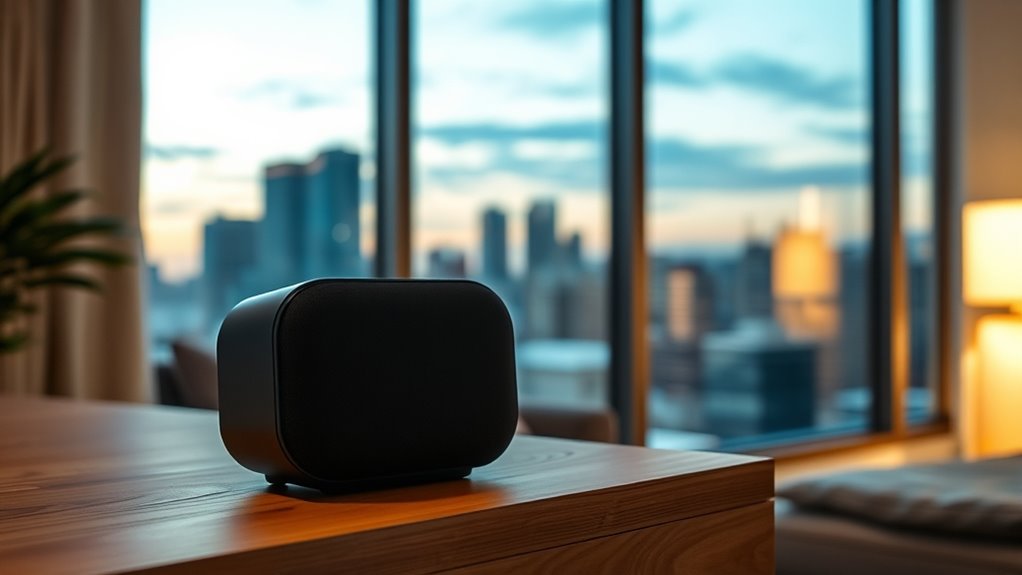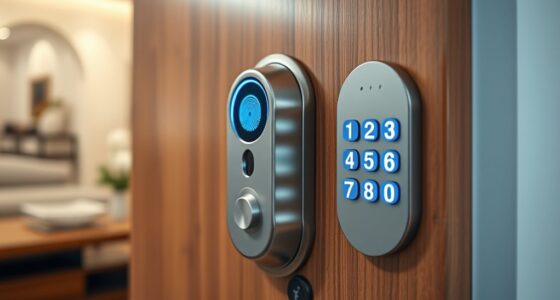Alexa is designed to listen only for its wake word, not to record or transmit everything you say. It constantly listens for phrases like “Alexa” but stays silent otherwise. When it detects the wake word, it begins recording your command and sends it to Amazon for processing. You can control your privacy settings, review stored recordings, and mute microphones. To learn more about how Alexa manages privacy and listening behavior, keep exploring these features.
Key Takeaways
- Alexa uses built-in voice recognition to listen only for wake words, not continuously recording or transmitting all speech.
- Microphones are designed to detect trigger phrases and remain silent otherwise, ensuring privacy when not activated.
- Users can review, delete, or set automatic deletion for stored voice recordings to control their privacy.
- Alexa does not record conversations unless the wake word is detected and commands are spoken afterward.
- Muting microphones manually disables listening, preventing any audio from being captured.
How Alexa Detects Wake Words and Starts Listening

When you say the wake word, such as “Alexa,” the device actively listens for that specific phrase using built-in voice recognition technology. This process involves constantly monitoring the audio around it for the trigger phrase without recording or transmitting everything you say. Once the wake word is detected, Alexa begins recording your commands to process your request. While this sounds straightforward, it raises privacy concerns for many users. You might worry about whether your conversations are being overheard or stored without your knowledge. Thankfully, the device is designed to listen only for the wake word and not to record continuously. Understanding how Alexa detects wake words helps you feel more in control of your privacy and aware of the technology’s capabilities. voice recognition technology plays a crucial role in how the device functions and maintains user privacy.
What Data Does Alexa Collect and Store?

When you use Alexa, it records and stores your voice interactions to improve its performance. These recordings are saved in your account, and Amazon may share them with third parties for various reasons. Understanding what data is collected and how it’s shared helps you better protect your privacy. Consent management options allow you to control the data Amazon collects and stores from your interactions.
Voice Recordings Storage
Alexa continuously records and stores your voice interactions to improve its performance and personalize your experience. These recordings, known as voice data, are saved in your account and can be accessed or deleted through the Alexa app or website. According to Amazon’s privacy policies, your voice data helps refine Alexa’s understanding of your commands, but you have control over what’s stored. You can review and delete recordings manually or set up automatic deletion options. It’s important to understand that the stored voice recordings are not only used for improving services but also for troubleshooting and security purposes. While Alexa’s privacy policies outline how your data is managed, staying informed about your voice recordings ensures you maintain control over your personal information. Additionally, track development is vital for creating effective and engaging voice interactions.
Data Sharing Practices
Amazon’s Alexa collects and stores a variety of data beyond your voice recordings to enhance its functionality and security. This includes your device usage, preferences, and even location data. Such information helps improve voice recognition and personalize services. However, concerns about third-party sharing remain. Data shared with third parties can include voice data, account details, and interaction history, often for advertising or analytics. You should review privacy settings regularly. Here’s a quick overview:
| Data Type | Purpose | Third Party Sharing |
|---|---|---|
| Voice Data | Voice recognition and commands | Sometimes for advertising |
| Usage Data | Service improvement | Limited, with consent |
| Location Data | Location-based services | Usually shared with partners |
Stay informed about what info is shared and how it’s protected. Additionally, understanding the data collection practices can help you make more informed privacy choices.
The Role of Microphones in Smart Speakers
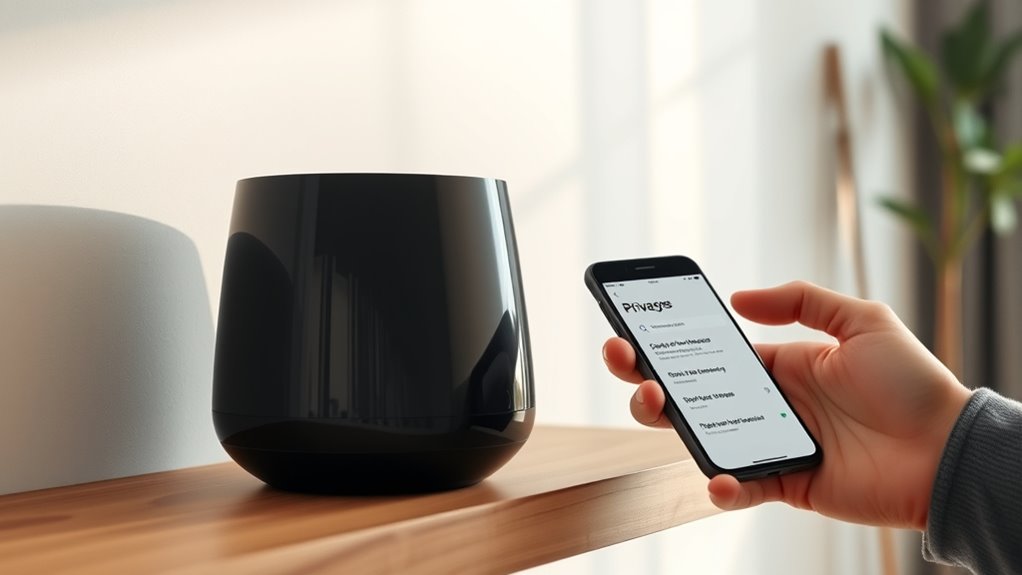
Microphones are the core components that enable smart speakers to listen and respond to your commands. They capture your voice, allowing the device to process requests through voice recognition technology. Microphone sensitivity determines how well your speaker picks up sounds, even from across the room. High sensitivity ensures it detects commands accurately, but can also pick up background noise. The placement and quality of microphones impact how effectively your voice is understood. Many smart speakers incorporate multiple microphones to improve voice pick-up and reduce false activations. Understanding this helps you realize that microphones are indispensable for seamless interaction. They work silently in the background, listening for wake words, and translating your speech into actions. This crucial role makes microphones the backbone of your smart speaker experience. The importance of microphone placement can significantly influence device performance and user privacy.
Common Myths About Alexa’s Listening Habits

Many people believe that smart speakers are constantly listening and recording everything you say, but this isn’t entirely true. Alexa uses voice recognition technology to detect wake words, activating only when you say “Alexa” or similar commands. The device doesn’t record or analyze conversations unless prompted. Some common myths include that Alexa eavesdrops on private moments or stores everything indefinitely. To clarify, here’s a quick overview:
| Myth | Reality | Privacy Concern Addressed |
|---|---|---|
| Always listening | Listens only after wake word | Reduces privacy worries |
| Recording all conversations | Records only when activated by wake word | Ensures privacy is maintained |
| Listening in background | No continuous listening occurs | Eases privacy concerns |
| Sharing data with third parties | Data is stored securely and with user control | Protects your privacy |
Understanding this helps you better manage privacy with Alexa.
Privacy Settings and Controls for Alexa Users
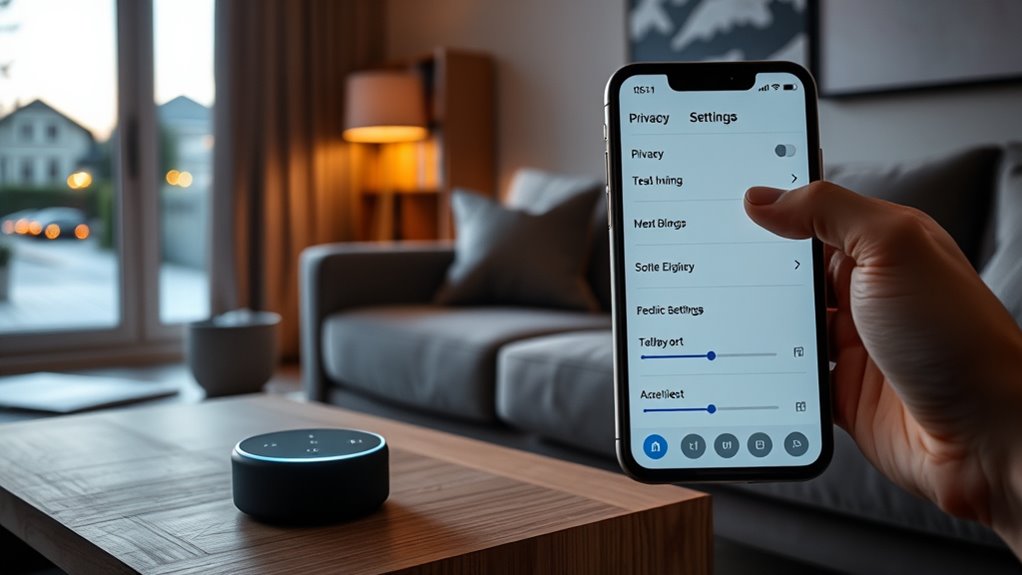
To maintain control over your privacy, it is essential to understand the available settings and controls on your Alexa device. You can manage your privacy concerns by adjusting voice activation features and reviewing your data. Alexa offers options to mute the microphone manually or disable voice recordings altogether. You can also set up voice profiles so Alexa recognizes who is speaking, reducing accidental recordings. Additionally, you can delete voice recordings regularly or turn off recording storage entirely. These controls give you more transparency and help address privacy concerns. By proactively managing these settings, you guarantee your privacy stays protected while still enjoying the convenience of Alexa’s features. Privacy and Cookie Usage also emphasizes user control over data and preferences, reinforcing the importance of managing your privacy settings effectively.
Best Practices to Protect Your Privacy
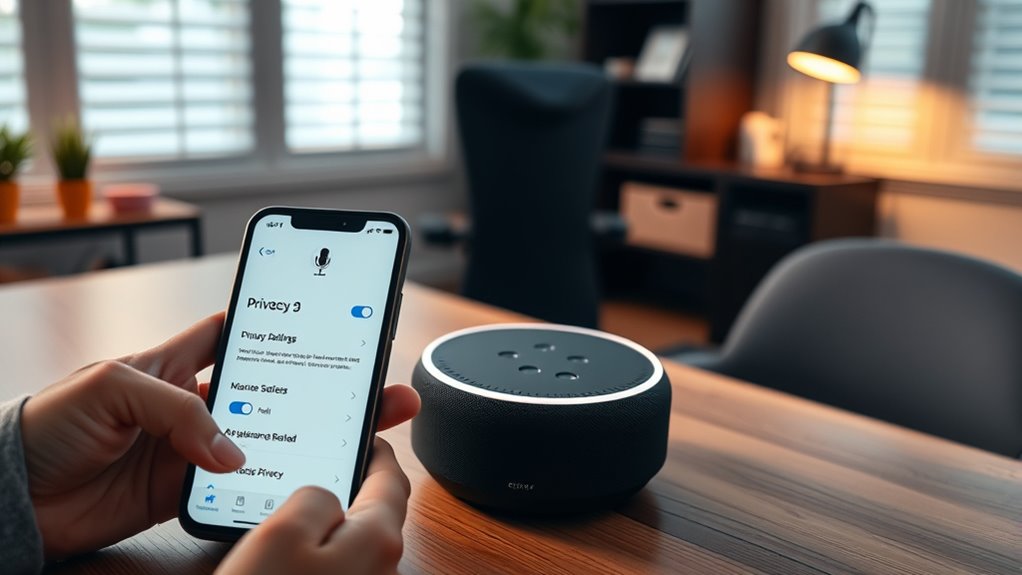
To protect your privacy, make it a habit to clear your voice commands regularly so your smart speaker doesn’t store unnecessary recordings. Manage your device settings to control what data is saved and who has access. These simple steps help keep your information secure and give you more control over your smart speaker. Additionally, being aware of hidden mysteries associated with these devices can help you better understand potential risks and how to mitigate them.
Clear Voice Commands Regularly
Regularly clearing your voice commands helps protect your privacy by reducing the amount of stored data that could potentially be accessed or misused. This practice supports voice command optimization by ensuring your smart speaker only retains necessary commands. It also helps you stay aware of privacy policy updates that might affect data handling. To keep your privacy in check, consider these steps:
- Delete stored voice recordings through your device’s app.
- Review and accept privacy policy updates regularly.
- Limit voice command history to essential commands.
- Use voice commands to manage your data storage settings.
- Being aware of cookie usage and how it impacts your privacy can further enhance your security.
Manage Device Settings
Managing your device settings is a key step in safeguarding your privacy beyond regularly clearing voice commands. You can adjust voice recognition features to limit how your smart speaker identifies your voice, reducing the risk of unintended recordings. Device customization options allow you to disable or mute microphones when not in use, giving you more control over when your device listens. Check your privacy settings regularly to review what data is being stored and delete any unnecessary recordings. Many devices also let you disable features like voice recognition altogether or set up voice profiles to ensure only authorized users can activate certain functions. Taking these steps helps prevent accidental activation and keeps your personal information more secure. Incorporating self-awareness techniques can also help you better understand and manage your device usage choices.
The Future of Smart Speaker Security
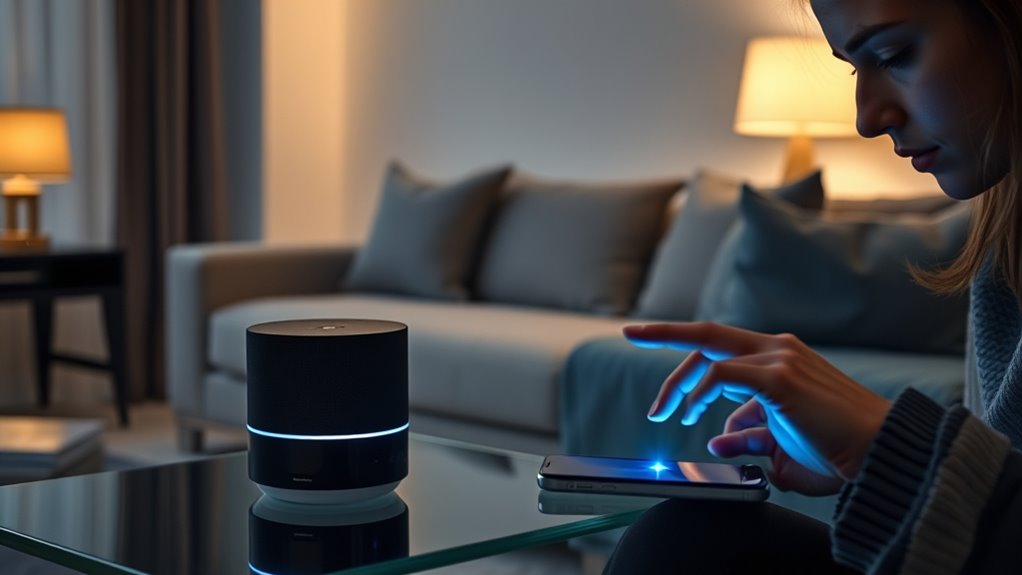
The future of smart speaker security hinges on developing stronger protections against evolving cyber threats. As privacy concerns grow, manufacturers will need to improve voice recognition technology to better differentiate between users and unauthorized listeners. You can expect enhanced encryption methods to safeguard your data and prevent breaches. Future innovations might include more transparent privacy controls, giving you clearer options for managing your voice recordings. Additionally, regular security updates will become standard, reducing vulnerabilities. You’ll likely see smarter device authentication, such as multi-factor verification, to prevent unauthorized access. Security measures will also become more sophisticated to protect user information effectively.
Frequently Asked Questions
Can Alexa Hear Conversations When It’S Not Actively Listening?
You might wonder if Alexa hears conversations when it’s not voice-activated. While it only records when you use the wake word, privacy concerns persist because it’s always listening for that trigger. Alexa’s microphones are designed to activate only with voice commands, but accidental activations can happen. To protect your privacy, you can disable recording features or mute the microphone when not in use, ensuring your conversations stay private.
Does Alexa Record Background Noises Unintentionally?
Think of Alexa as a vigilant guard dog—always alert to voice activation. While it’s designed for voice commands, background noise detection can sometimes cause it to record unintended sounds. However, Alexa doesn’t intentionally record background noises; it’s more like a passive listener. If your smart speaker detects a sound similar to its wake word, it may start recording, but it doesn’t actively spy on you without your command.
How Secure Is the Data Stored on Amazon’S Servers?
You might wonder how secure your data is on Amazon’s servers. Rest assured, Amazon uses data encryption to protect your information during transmission and storage, helping safeguard your privacy. They also implement strict access controls and security measures to prevent unauthorized access. While no system is completely invulnerable, these practices show Amazon’s commitment to maintaining user privacy and keeping your data secure.
Are There Legal Limits to Amazon’S Data Collection?
You might wonder if Amazon faces legal limits on data collection. Privacy regulations set boundaries, requiring transparency and user consent, restricting what data they can gather and store. Amazon employs data encryption to protect your information, but legal rules still govern their practices. You have rights to privacy, and companies must follow laws, balancing innovation with respecting your personal data. Stay informed, question policies, and understand your rights to maintain control over your privacy.
Can I Completely Disable Alexa’S Listening Capabilities?
You can disable Alexa’s listening capabilities by using device mute options, which stop the microphone from actively listening. This enhances your voice command privacy, ensuring Alexa only responds when you manually unmute it. While you can’t completely disable listening without disconnecting the device, muting provides a practical way to control when Alexa listens. Always review your device settings to make sure your privacy preferences are properly configured.
Conclusion
So, while Alexa only listens when it detects its wake word, the boundaries of privacy can blur unexpectedly. Are you truly in control of what’s recorded, or is there more happening behind the scenes? The truth remains elusive, and as technology advances, the line between convenience and privacy might become even more uncertain. Stay vigilant—your privacy could depend on it, because what you don’t see might be listening more than you think.
